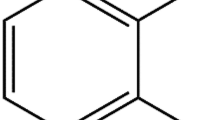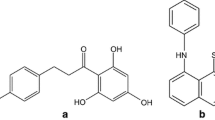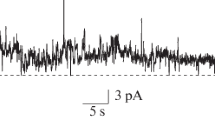Abstract
The weak hydrophobic acid carbonylcyanide-4-(trifluoromethoxy)phenylhydrazone (FCCP) is a protonophoric uncoupler of oxidative phosphorylation in mitochondria. It dissipates the electrochemical proton gradient (ΔμH +) increasing the mitochondrial oxygen consumption. However, at concentrations higher than 1 μM it exhibits additional effects on mitochondrial energy metabolism, which were tentatively related to modifications of electrical properties of the membrane. Here we describe the effect of FCCP on the binding of 1-anilino-8-naphthalene sulfonate (ANS) to 1, 2-dioleoyl-sn-glycero-3-phosphocholine (DOPC) and 1,2-dipalmitoyl-sn-glycero-3-phosphocholine (DPPC) unilamellar vesicles. FCCP inhibited the binding of ANS to liposomes either in the gel or in the liquid crystalline phase, by increasing the apparent dissociation constant of ANS. Smaller effect on the dissociation constant was observed at high ionic strength, suggesting that the effect of FCCP is through modification of the electrostatic properties of the membrane interface. In addition, FCCP also decreased (approximately 50 %) the quantum yield and increased the intrinsic dissociation constant of membrane-bound ANS, results that suggest that FCCP makes the environment of the ANS binding sites more polar. On those grounds we postulate that the binding of FCCP: i) increases the density of negative charges in the membrane surface; and ii) distorts the phospholipid bilayer, increasing the mobility of the polar headgroups making the ANS binding site more accessible to water.
Similar content being viewed by others
References
Ames BN (1966) Assay of inorganic phosphate, total phosphate and phosphatases. Methods Enzymol 8:115–118
Benz R, McLaughlin S (1983) The Molecular Mechanism of Action of the Proton Ionophore FCCP (Carbonylcyanide p-Trifluoromethoxyphenylhydrazone). Biophys J 41:381–398
Chance B, Williams GR, Hollinger G (1963) Inhibition of electron and energy transfer in mitochondria. III Spectroscopy and respiratory effects of uncoupling agents. J Biol Chem 278:439–444
Chen PS, Toribara TY, Warner H (1956) Microdetermination of phosphorus. Anal Chem 28:1756–1758
Disalvo EA, Bouchet AM (2014) Electrophoretic mobility and zeta potential of liposomes due to arginine and polyarginine adsorption. Colloids Surf A 440:170–174
Fortes, PAG (1972) Structural properties of the human red cell membrane and anion permeability studied with fluorescence probes. Ph. D. Dissertation, University of Pennsylvania, Philadelphia
Gains N, Dawson AP (1975) Transmembrane electrophoresis of 8-anilino-1-naphtalene sulfonate through egg lecithin liposome membranes. J Membr Biol 24:237–248
Haynes DH (1974) 1-anilino-8-naphtalenesulfonate: a fluorescent indicator of ion binding and electrostatic potential on the membrane surface. J Membr Biol 17:341–366
Haynes DH, Staerk H (1974) 1-Anilino-8-naphtalenesulfonate: a fluorescent probe of membrane surface structure, composition and mobility. J Membr Biol 16:313–340
Hess HH, Derr JE (1975) Assay of inorganic and organic phosphorus in the 0.1–5 nanomole range. Anal Biochem 63:607–613
http://www.avantilipids.com/index.php?option=com_content&view=article&id=533&Itemid=297. Accessed 20 December 2013.
Lakowicz, JR (2006). Instrumentation for fluorescence spectroscopy. In principles of fluorescence spectroscopy. New York, Springer, pp. 27–61
Monteiro JP, Martins AF, Lúcio M, Reis S, Geraldes CFGC, Oliveira PJ, Jurado AS (2011) Interaction of carbonyl-p-trifluoromethoxyphenylhydrazone (FCCP) with lipid membrane systems: a biophysical approach with relevance to mitochondrial uncoupling. J Bioenerg Biomembr 43:287–298
Nicholls DG, Ferguson SJ (2002) Chemiosmotic energy transduction. In: Bioenergetics3. Academic, London, pp 3–14
Reyes J, Benos DJ (1984) Changes in interfacial potentials induced by carbonylcyanide phenylhydrazone uncouplers: possible role in inhibition of mitochondrial oxygen consumption and other transport processes. Membr Biochem 5:243–268
Robertson DE, Rottenberg H (1983) Membrane potential and surface potential in mitochondria. fluorescence and binding of 1-anilinonaphtaleno-8-sulfonate. J Biol Chem 258:11039–11048
Terada H (1990) Uncouplers of oxidative phosphorylation. Environ Health Perspect 87:213–218
Author information
Authors and Affiliations
Corresponding author
Electronic supplementary material
Below is the link to the electronic supplementary material.
ESM 1
(DOCX 24 kb)
Rights and permissions
About this article
Cite this article
Cutró, A.C., Montich, G.G. & Roveri, O.A. Effect of carbonylcyanide-4-(trifluoromethoxy)phenylhydrazone (FCCP) on the interaction of 1-anilino-8-naphthalene sulfonate (ANS) with phosphatidylcholine liposomes. J Bioenerg Biomembr 46, 119–125 (2014). https://doi.org/10.1007/s10863-014-9545-0
Received:
Accepted:
Published:
Issue Date:
DOI: https://doi.org/10.1007/s10863-014-9545-0




